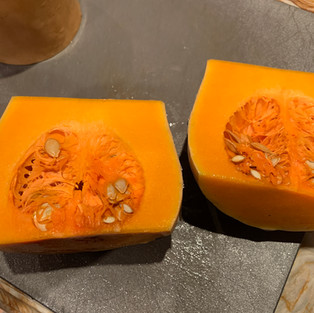Low sodium brown butter butternut squash
- Thuy

- Nov 3, 2020
- 3 min read
Updated: Nov 4, 2020
This is a warm, flavorful dish that cooks up in just 15 minutes on the stove which makes it a great candidate for a Thanksgiving side dish when the oven isn't available. Or make it in the oven if that's easier. It pairs perfectly with leafy greens and crunchy salad toppings for warm fall salad.

Servings: Makes about 6-7 cups (1 large butternut squash) Sodium: 6 mg sodium per cup Time: About 30 minutes to prep, 15 minutes to cook
Ingredients:
2 tablespoons butter 1 large butternut squash, cut in 3/4 inch cubes (See TIPS, below on how to cut a butternut squash)
1/4 tsp cinnamon
1/4 tsp nutmeg
1/4 tsp paprika
4 tablespoons cooking oil, divided
1/2 cup water, divided
2 scallions, sliced thin
fresh ground pepper to taste
1/2 cup unsalted dried cranberries (optional)
1/2 cup toasted pecans (optional)
1) Make the brown butter - in a small saucepan, slowly melt butter on medium-low heat, stirring constantly, until it browns, about 4-6 minutes. I used a 1.5 quart stainless steel pan so that it's easy for me to see when the butter starts to get brown. The butter starts to melt, and then it gets frothy, and then it goes from frothy to light brown and that's when you take it off the stove and pour it into a bowl. The butter will go from light brown to dark brown (burnt) fast so pay attention. You don't have to do this, you could just use butter but this extra little step gives the squash so much more flavor!
2) Cook the butternut squash, one half at a time - in a large bowl, toss the butternut squash with cinnamon, nutmeg, paprika, and 2 tablespoons cooking oil. Heat 1 tablespoon of cooking oil on medium-high heat in a large 12-inch skillet (non-stick works best) and cook HALF of the squash. I cook half at a time so it doesn't overcrowd the pan.
Let the squash brown in the pan for about 3-4 minutes, stirring occasionally. Then add about 1/4 cup of water to the hot pan and cook, covered, until the water has evaporated (about 3 minutes). This basically steams the squash and gets it soft and tender faster than just cooking it in the hot skillet.
After the water has evaporated, take the cover off and add half the brown butter to the pan and continue to cook over medium-high heat to crisp the squash again, about 3-4 minutes, stirring occasionally. The squash should be soft by now but if it isn't, do another round of steaming but with just 2 tablespoons of water this time. Add half the scallions when the squash is done cooking but still hot so the scallions will wilt a little. The scallions really add so much flavor to this dish, so I sometimes double up on them. Transfer to a serving plate and cook the other half of the squash in the same way. If you're serving with dried cranberries, I like to add them when the squash is still hot so they heat up a little, too. For pecans, or any other nuts, sprinkle on top just before serving so they stay toasty.
To make this in the oven
Preheat oven to 425°F. In a large bowl, toss the butternut squash with cinnamon, nutmeg, paprika, and 2 tablespoons cooking oil. Spread the squash evenly on two parchment-lined baking sheets (mine are 12x17 inches) and bake for 20-25 minutes until soft. Toss with brown butter and scallions while the squash is still hot.
How to cut a butternut squash
Cutting up a butternut squash can be time consuming, difficult, and dangerous. I often buy them pre-cut but they do taste better if you cut them up yourself. Do it slowly and carefully so you don't cut yourself. Here's what I do:
1) Cut off both ends, and then cut in the middle just above where the squash gets wider. Now you have flat surfaces on each end of the squash so it won't roll around when you cut it.
2) Stand each side up on its flat end, and cut in half. Then take a spoon and scrape out the seeds. I have this grapefruit spoon that is great for scraping out seeds.
3) You have 4 pieces now. Lay each piece on its long, flat side and cut into about 3/4 inch half circles. Then lay each half circle flat, and cut the skin off in 4-5 little pieces. Some people peel the skin with a vegetable peeler but that just seems dangerous to me.
4) Finally, cut each peeled piece into smaller 3/4 inch cubes.










































Comments